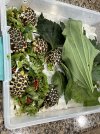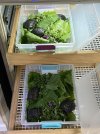Your disagreement is based on ignorance and lack of experience with the species and factors in question.i would disagree the cause of death is obvious....... it would take some serious effort to kill a tortoise through dehydration, first year desert tortoises have been shown to survive 16months without water...... their dehydration tolerance is pretty well documented and studied....... i've read necropsies on like a dozen tortoise that were known to have died after a prolonged drought, the most common finding was accumulated iron in the liver, and bladder stones , there was no mention of kidney disease, aside from one with gout......first year hatchlings survived a year long drought better than older juveniles , they attributed it to the egg yolk retained internally...... during a drought a desert tortoise can lose up to 40%of it's body water, and reduce it's metabolism by70-90%........
Hatchling desert tortoises in the typical beef jerky maker style enclosures or outside all day here in the dry southwest as is usually recommended by "experts" usually results in the death of the baby. Same with sulcatas and leopards.
It is a waste of our time to continue arguing over what we think happens in the wild when we have first hand evidence of what happens when they are kept this way in captive conditions. Well... one of us has first hand evidence...
This pattern is seen again and again when breeders skip the brooder box, soak once a week, if at all, and keep them in a dry enclosure with low humidity. It is obvious.


